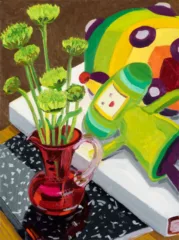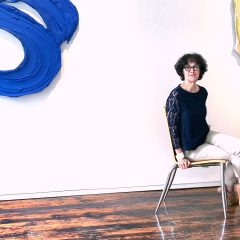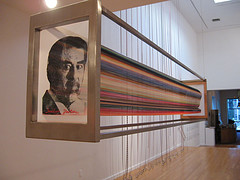
Relationship:Buddhism-Saddamism. This one shows Saddam. Bush is on the far side.
The execution by hanging of Saddam Hussein served as a nice reminder that I wanted to bring up Xiang Yang’s exhibit, Beyond the Duplicated Voice at the Painted Bride. Even though Roberta wrote a great post on it, I wanted to add my two cents because I’m such a fan.
George W. Bush’s portrait is paired with Saddam Hussein’s, and it seems like a dead-on coupling, the two of them undone by one another. They are each framed, several feet apart, with the embroidery threads that edge the portraits stretched across the space between them.
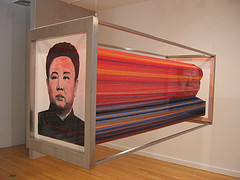
Relationship:Buddhism-Saddamism, by Xiang Yang. This pairing is of North Korean dictator Kim Jung-Il and Mao Tse-Tung.
Xiang also has coupled together state portraits of Mao-Tse Tung and Kim Jung Il. Ha.
Those stretches of embroidery thread, which create a solid-looking streak of color, form a surface around a hollow space, an inside sculpture/portrait of air that’s at once something and nothing. With the departure of Hussein, he seems to me to be something and nothing all at once. And with Bush’s hollowness between the ears and his loss of power (and the shift of power in Congress), he too seems like something and nothing all at once. And the stretch between the two of them, on opposite sides of the world and the sculpture, is hyped to warp-speed by the cartoonlike trail of color between the heads.
The delicacy of balance and oppostion, of sameness and difference, of somethingness and nothingness, gives these sculptures their resonance, a see-sawing that is matched by the materials–delicate thread, bold metal framework.
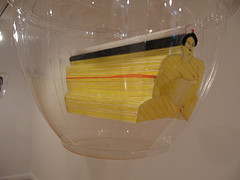
A Xiang Yang’s Floating Object, with Floating World content.
Xiang also has his sexy lunch box embroideries on exhibit, which raise the same issues in another arena. Both bodies of work borrow their imagery from popular sources– ubiquitous state portraits, ubiquitous pulp cartoons and porn–and make them into something else. The lunch boxes suggest consumption of product and diposability. The joke about the lasting powers Chinese food immediately comes to mind. And what looks like something solid, be it the image or its trailing threads, represents something hollow and not all that satisfying. Some of this imagery looks Asian, some of it American, but the message is there’s a sameness.
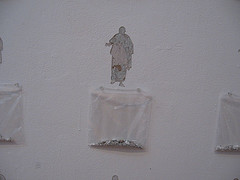
This is one of a grid of 56 Buddhas carved into the wall, the removed plaster hung in a plastic lunch bag below each carving.
The lack of corporeality and the disposability carries over into the Buddhas carved into the wall.
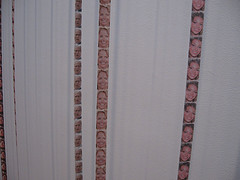
Newsreel, detail. These long streamers of faces in the news hung from the double-height ceiling to the floor, looking much like unrolled film strips. The two show W. and (I think) Katie Couric.
In Newsreel, the long strands of celluloid tape with images transferred from the news also raises the flimsiness issue–and brings the outsider’s eye to our culture. The film format promises motion but the images are static, the facial expressions unchanging.
At the same time that Xiang, who is Chinese born and still speaks halting English, is positing flimsiness in his use of nothingness, he is also positing its opposite–that nothing is something, is worthy of our attention, not a notion native to our culture.
And speaking of what’s not native to our culture, Xiang’s work also has a New York vibe; although he resides here, he has a New York studio. His work shows it. He pulled a Banksy at P.S. 1 and at the Philadelphia Museum of Art in 2001, sneaking his own work into the museums. And his use of embroidery thread calls not only to Asian manufacturing of embroidered goods that we use here, but also to other Asian artists, like Do-Ho Suh, and his Paratrooper.
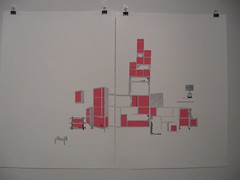
White Storage with Lamp (West Elm, Spring 2006), by Leslie Mutchler, 30″ x 44″, collage using catalog images
Also at the Bride, Leslie Mutchler‘s portraits of the emptiness of furnishings make a nice pairing with Xiang’s work. I don’t have anything to add to Roberta’s comments. For more images, my Flickr set is here.


